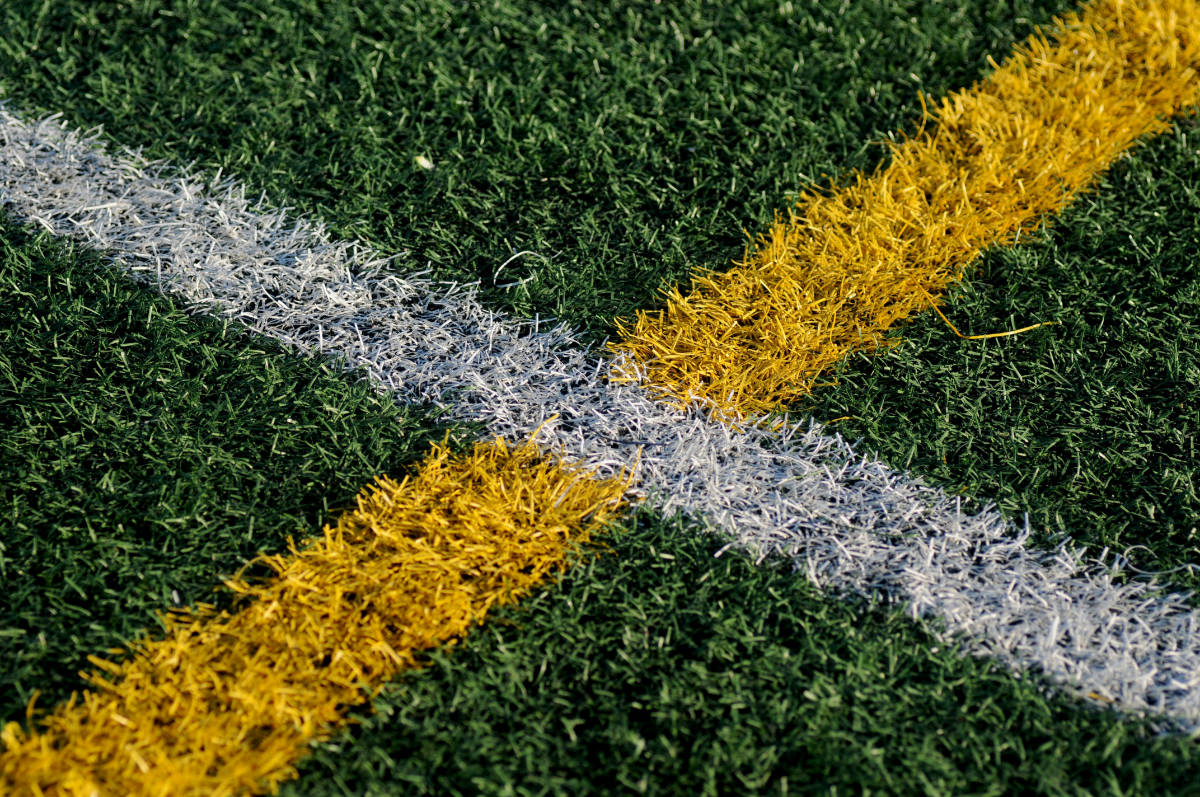Records have shown that the fields that Native Americans played on were miles and miles long. Fortunately for us, the lacrosse field has shrunk over time, making it much more manageable. There are quite a few lines on the field, but this guide will tell you all you need to know about them and why they’re important.
The Perimeter
The lacrosse field is 110 yards long by 60 yards wide and is shown by a bold, white border along the edge of the field. The main thing to know about the boundary of the green is that the ball must stay within those lines in order for play to continue. However, you, as the player, can leave the bounds, as long as you are not in contact with the ball and not an active part of a play. If the ball, or the ball carrier, crosses the sideline, then possession will switch to the opposing team.
When a shot on goal misses and leaves the boundaries, whoever is closest to the ball at the time it crosses the line gets possession. Sometimes that’s the goalie and sometimes that’s a field player. The important thing to remember is to always chase a missed shot on goal with your stick outstretched; you should always be fighting for the ball, on the ground and in the air.
In the case that the ref is unsure who last touched the ball as it exited the sidelines, there will be a toss up, or a throw. One player from each team will stand by each other, one meter apart, while the ref tosses the ball in the air towards them. They will then fight for possession and play will continue.
Restraining Lines
There are two restraining lines on the field, which break the field up into thirds. The three low attack players and the three low defenders will line up on these lines at each draw; the three defenders at the line near their own goalie, and the three offense players on the line by the opposing goalie.
The lines are also the markers for offside. The rule for offside is that four players must be behind the restraining line of the zone in which a play is in motion. To break that down a little bit, say, for example, that your team has possession of the ball and is in the other team’s zone. While your offense is attempting to score, four players need to be behind the restraining line of the opponent’s zone. The three low defenders and an extra player will have two thirds of the field to roam around in until there is a turnover or your team scores a point. The midfielders aren’t the only players who can go into both zones, there just needs to be clear communication of who will stay behind so that your team isn’t offside.
The Goal Line and the Crease
Each goal is encircled by what is called the crease. The diameter of the crease is 6 meters, or 18 feet, and is where the goalie will spend most of her time. The crease acts as a means of protection from offense, since it is illegal for anyone from the opposing team to enter this circle. If an offense player does enter the crease, the ball will be turned over. Any goal that was scored as the shooter crossed the crease will be revoked as well.
Goalies are not limited to the space in the crease. The protection that they have in the crease will not be applied as they leave the circle, however. When they are out of the crease, field players will be able to stick check them, just like other players. In the case that the goalie can’t find a pass to a field player after she stops a shot, she may drop the ball in the crease and step out. Once the goalie exits the crease, a defender may enter the circle to take her place and pick up the ball to continue the transition. While defending, a player is also allowed to run through part of the crease, as long as she is defending the ball carrier and is a sticks length away from her.
The 12-Meter and 8-Meter
In each zone, there are markings for a 12-meter arc and an 8-meter arc. These represent the 12-meter and 8-meter mark from the goal line, which cuts straight through the crease. These lines mainly act as markers for the players and can help with spatial awareness and when to drive to goal.
However, in terms of rules, anytime a major foul is performed by the defense, an offensive player gets a free position, or a free shot on goal. Depending on the foul and where it happened, you might line up on the 12 or 8-meter. Minor fouls will require a pass before anyone is allowed to take a shot on goal.
Defense and Offense in the 12-Meter and 8-Meter
If you are on offense, you should get comfortable using every inch of that space, don’t feel like you are confined to that 12-meter line. Think of those lines as a simple guide. Once you realize how much space there is just past the 12-meter, the possibilities for plays are endless.
Typically, the 12-meter is where you’ll pass the ball around to keep the defenders on their toes, and the 8-meter is where you will cut while looking for a shot on goal. Since the 12-meter arc is a little far from the goal, I wouldn’t start cutting to the goal until that 8-meter mark. The goalie and the defenders will have less time to react to your cuts and dodges.
If you are a defender, on the other hand, I would stick relatively firmly to those lines. The farther out you follow an offensive player, the higher the chance of her getting around you. If the attackers are casually passing around the 12-meter, hold your stick up high so that your teammates know who you’re marking. However, don’t waste energy heavily guarding your girl until she crosses that 8-meter mark. Any offensive player within the space of the 8-meter mark should always be tightly defended, the chance of her going to goal is much higher.
Wrap Up
To be honest, getting comfortable with the field simply takes practice. Knowing how much space you have and which lines to pay attention to requires some hours out on the field. The more you practice, the more the field will feel like your home away from home!

